Planning your own trip? Prepare for your trip
Use Rough Guides' trusted partners for great rates
- Portugal
- Sintra
Plan and book your private, tailor-made tour with vetted local experts
The hilltop town of Sintra deserves at least a day, though two or three will let you explore its palaces, gardens, and wild coastline. Once a cool summer retreat for Portugal’s royalty, it has lured the rich, famous, and literary, from Lord Byron to Gothic novelist William Beckford. Awarded UNESCO World Heritage status in 1995, Sintra’s “cultural landscape” blends Romantic architecture with natural beauty, a mix that has influenced garden and palace design across Europe.

Colourful Sintra, Portugal palace Palácio da Pena © Shutterstock

Hi! I’m Joel, your Portugal travel guide to one of country’s most photographed towns, ready to show you how to get here, what to see, where to stay, and the shortcuts that make sightseeing smoother. Sintra’s mix of fairytale palaces, subtropical gardens, and Atlantic views is unforgettable, but it’s also a place where timing and planning matter. Get them right, and you’ll see why royalty and poets came here for inspiration.
Local tip
Pre-book a timed-entry ticket for Pena Palace and enter the park at opening. Head straight to the exterior terraces first, then do the interior after the initial rush. If the 434 bus queue is long, take a taxi or rideshare up to the Moorish Castle and walk 15-20 minutes through the park to Pena. Bring a light layer, Sintra’s microclimate can flip from sun to mist in minutes.
Best time to visit
Late spring (May-June) and early autumn (September-October) offer mild weather and manageable crowds. Summer is beautiful but packed, with long lines at Pena and the 434 bus. Winter is quieter and cheaper; expect damp mornings, fog, and occasional drizzle.
How to get to Sintra
From Lisbon’s Rossio Station, direct trains run roughly every 20 minutes and take about 40 minutes. From Oriente (handy for the airport), trains also run frequently. Driving is possible, but parking near the monuments is limited: park in town and use buses, taxis, or your feet.
Best areas to stay in Sintra
Sintra sits in the foothills of the Serra de Sintra, about 30km northwest of Lisbon in central Portugal. It’s close enough for an easy day trip yet far enough to feel like a different world, with cooler air and lush, forested hills.
Often listed among the best places to visit in Portugal, Sintra is well-placed for exploring the Atlantic coast at Praia das Maçãs or Azenhas do Mar, the wine-producing town of Colares, and the windswept cliffs of Cabo da Roca, the westernmost point of mainland Europe.


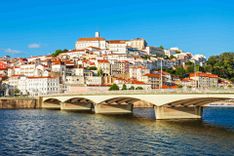
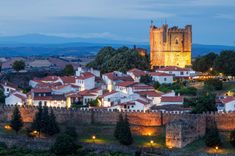

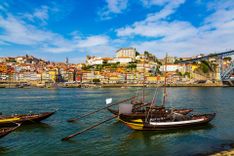










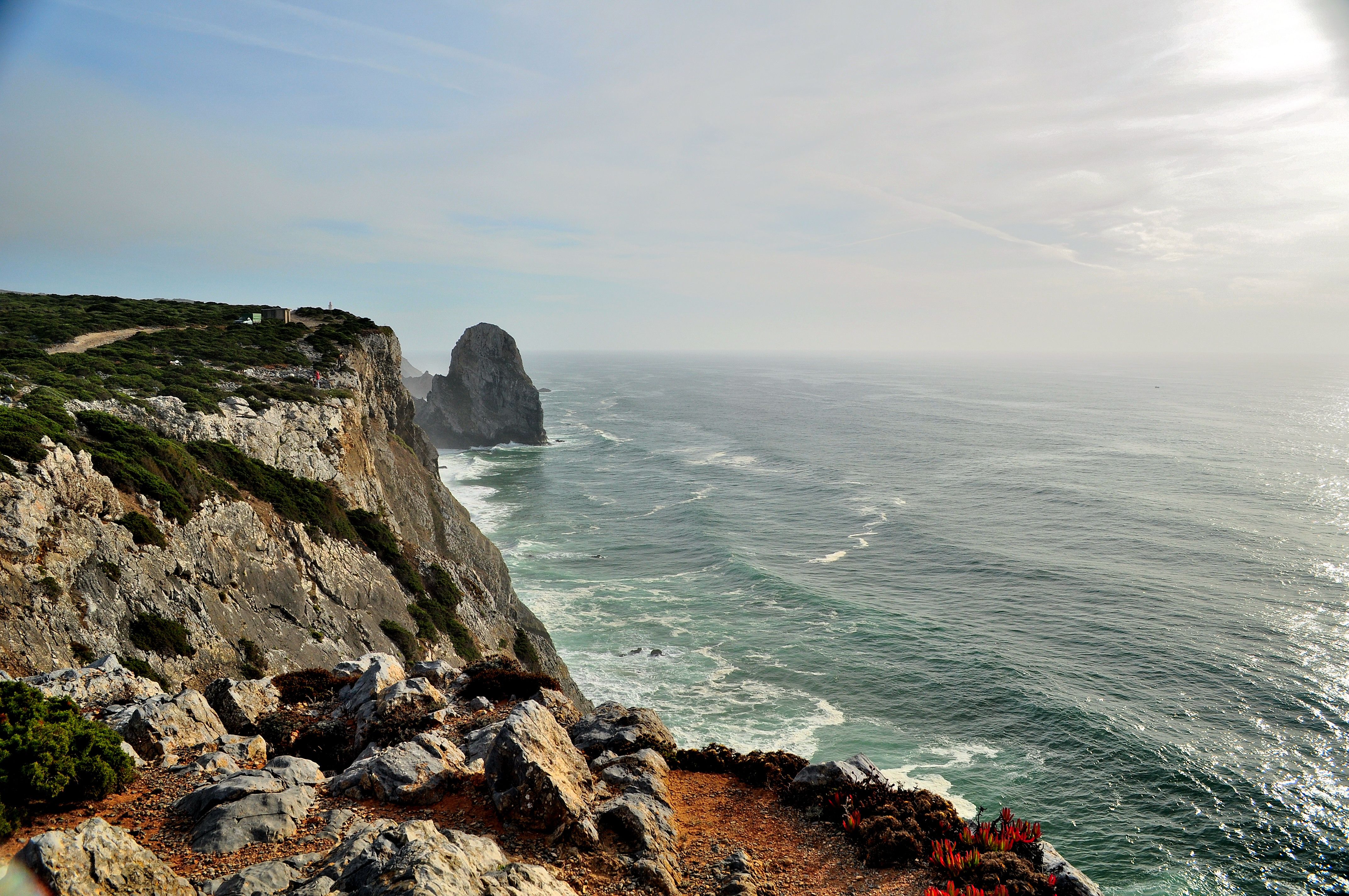
The rocky Sintra coast in Portugal
Sintra’s historic center is compact, but its main sights are scattered across steep hills and forested slopes. Walking is pleasant in the town itself, but getting between palaces often means tackling long uphill stretches; public transport or taxis save both time and energy.
You can see Sintra’s headline sights, Pena Palace, the Moorish Castle, and Quinta da Regaleira, in a single, well-planned day, but it will be fast-paced and involve a lot of uphill walking or bus rides.
Two days give you time to explore at a more relaxed pace, adding Monserrate Palace, the historic town center, and a stroll through the forest trails. You’ll also have space for a coastal detour to Azenhas do Mar or Praia das Maçãs.
Stay for three days if you want to dig deeper into the Serra de Sintra’s hiking routes, visit smaller palaces like Seteais, or combine sightseeing with the beaches and wineries of Colares.

Parque Natural de Sintra, Portugal
Accommodation in Sintra ranges from grand palaces-turned-hotels to cosy guesthouses tucked into the hills. Your choice will shape your visit: staying in the historic center puts you within walking distance of shops and cafés, while hillside retreats offer views and peace away from the daytime crowds.
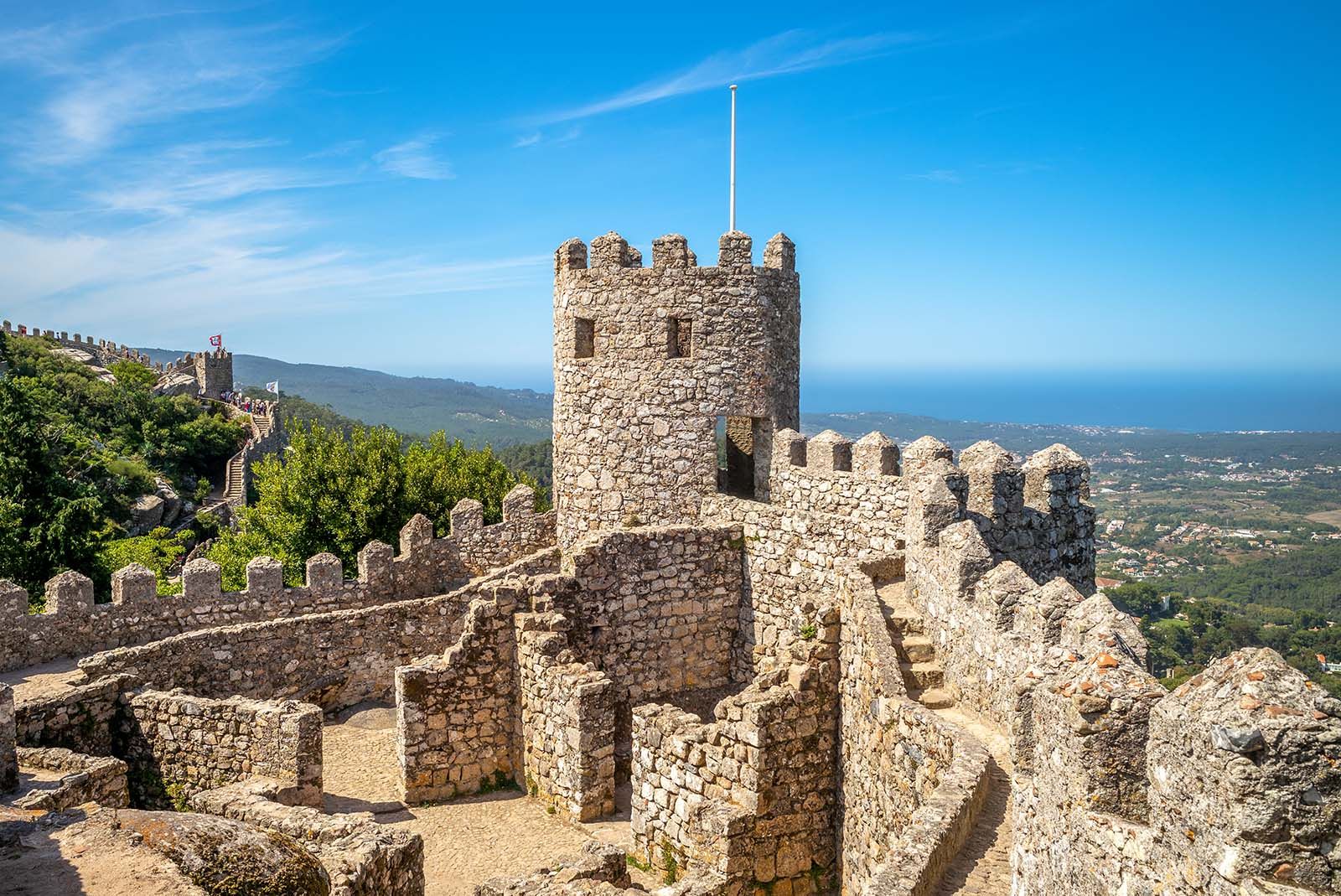
Castle of the Moors at Sintra, Portugal © Shutterstock
Sintra’s appeal is its blend of whimsical palaces, rugged hills, lush gardens, and Atlantic views, all packed into a compact area. You could spend days here and still find new corners to explore.
Sintra’s most famous landmark and the poster image of Portuguese Romanticism. Perched on a hilltop, its red-and-yellow towers, azulejo tiles, and mix of Moorish, Gothic, and Renaissance details look like they’ve been pulled from a fairytale.
Book a timed ticket in advance and arrive early. Take the terrace loop first for sweeping views over the Serra and the Atlantic before touring the palace interiors, which are furnished as they would have been for the royal family in the 19th century. The surrounding park is a destination in itself, a labyrinth of exotic plants, ponds, and walking paths.
A short uphill walk from Pena, this medieval fortress dates back to the 8th-9th centuries when the Moors ruled the Iberian Peninsula. The weathered stone walls snake along the ridge, offering panoramic views over Sintra, the coast, and Pena Palace peeking through the trees.
Wear sturdy shoes; the uneven steps and high towers are worth the climb. Go in the morning for cooler temperatures and fewer people on the narrow pathways.
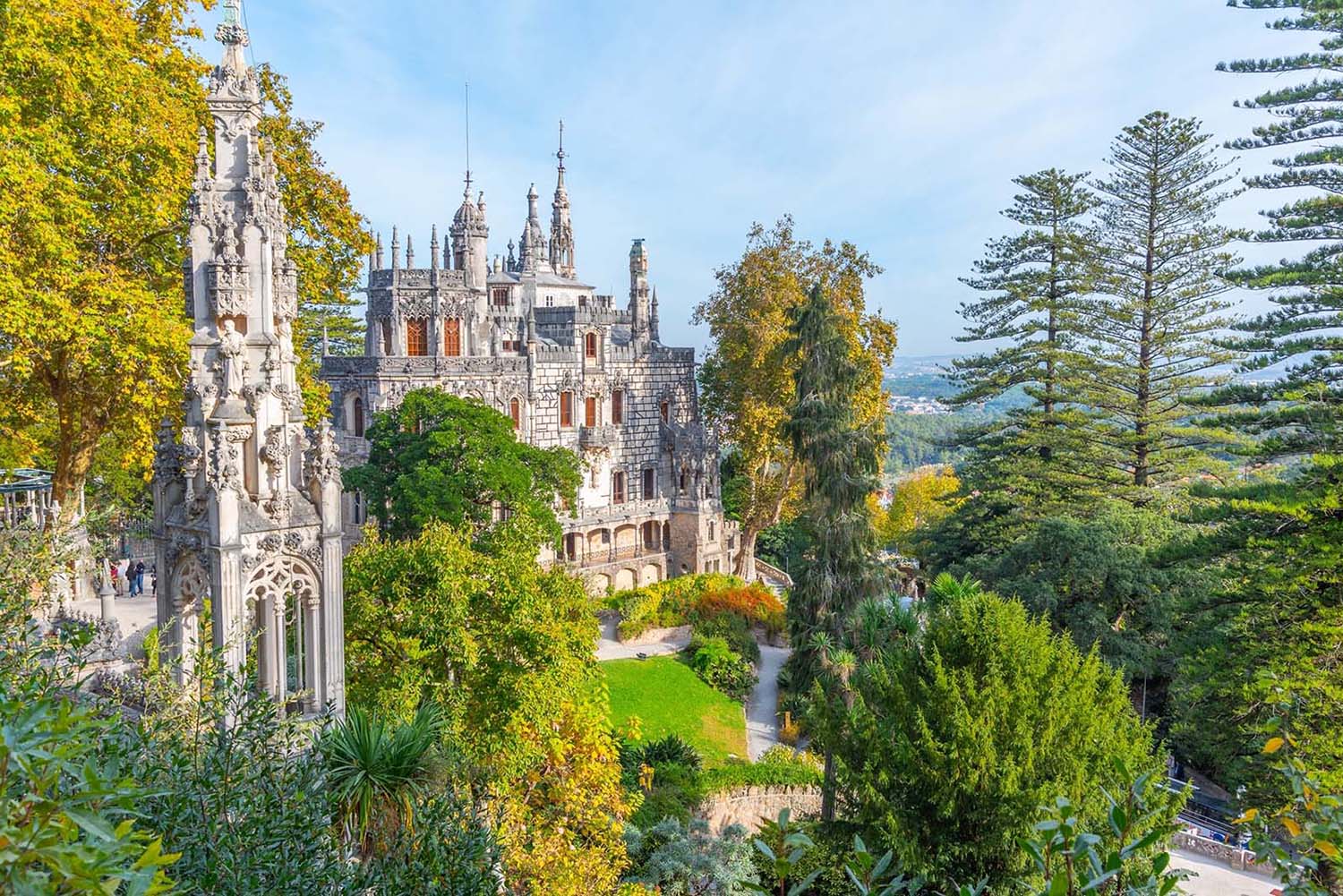
Main house of Quinta da Regaleira palace in Sintra, Portugal © Shutterstock
Part palace, part playground for the imagination, this 20th-century estate is packed with Gothic turrets, carved stonework, lush gardens, hidden tunnels, and the iconic Initiation Well, a spiral staircase descending deep into the earth.
It’s easy to spend two or three hours here wandering between grottoes, fountains, and moss-covered walls. A map is helpful, but getting lost is part of the fun. Late afternoon often sees fewer tour groups, making it easier to linger in the gardens.
Less crowded than Pena or Regaleira, Monserrate is a fusion of Gothic, Moorish, and Indian influences, surrounded by a vast botanical garden. The interiors are ornate but intimate, while the gardens are a paradise for plant lovers, with rare species from around the world.
Perfect for a quieter morning or afternoon, especially if you enjoy photography, the symmetry and detailing here are superb.
In the center of the old town, National Palace of Sintra was a royal residence from the Middle Ages to the 20th century. Its white façade and twin conical chimneys dominate the skyline, while inside, each room reveals a different slice of Portuguese history. Highlights include the Swan Room with its painted ceiling panels, the Arab Room with intricate tilework, and the Stag Room adorned with hunting scenes.
Allow at least an hour to explore, more if you want to linger over the details. Early morning or late afternoon visits avoid the midday tour group rush, and the location makes it easy to combine with lunch or a coffee in the historic center.
Seteais is now a luxury hotel, but its gardens and iconic neoclassical arch are open to visitors. The arch perfectly frames views of Pena Palace and the Moorish Castle to one side, and the Atlantic Ocean to the other. The manicured gardens are a peaceful place to pause, and the terrace café is a fine spot for a drink with a panorama.
It’s a pleasant 10-15 minute walk from Quinta da Regaleira, making it an easy add-on before heading toward Monserrate.

Capo Da Roca, the most western point of Europe, Portuguese municipality of Sintra, near Azoia © Tsuguliev/Shutterstock
Standing on the cliffs at Cabo da Roca, you’re at the very edge of mainland Europe. A lighthouse, rugged walking trails, and views of the endless Atlantic make it a dramatic stop. The weather is famously unpredictable; sunshine can turn to fog or high winds in minutes, so bring layers.
Many visitors combine Cabo da Roca with a coastal drive to Guincho Beach or a loop through the fishing town of Cascais. There’s a small visitor center and a certificate you can buy marking your visit to the continent’s westernmost point.
Just down the slope from Sintra, Colares produces wines unlike anywhere else in Portugal. The Ramisco vines grow in sandy soils protected by stone walls, resulting in bold reds that age beautifully. Visiting a local adega (wine cellar) is the best way to taste them: some offer tours of the old barrels and cellars before a tasting.
Pair your visit with a seafood lunch in the nearby villages of Azenhas do Mar or Praia das Maçãs. Late summer and autumn are harvest season, adding extra buzz to the area.
Running since 1904, the vintage tram connects Sintra with the seaside village of Praia das Maçãs. The open-sided carriages rattle through pine woods and past small farms before arriving at a sandy beach lined with cafés. The ride takes about 45 minutes and operates mainly on weekends and in summer.
Seats fill up quickly, so arrive early at the departure point in Sintra. At the beach, try the grilled sardines or clams at one of the waterfront restaurants before heading back.
The Serra’s network of trails offers a quieter side of Sintra away from palace queues. Popular hikes include the climb to Cruz Alta for the highest viewpoint in the park, and the trail from Peninha Sanctuary to the coast for wide-open Atlantic views. The forest is dense and often misty, adding an atmospheric touch.
Spring brings wildflowers, while autumn offers crisp air and fewer visitors. Wear good shoes, trails can be rocky or muddy, and carry water, as services are limited once you leave town.
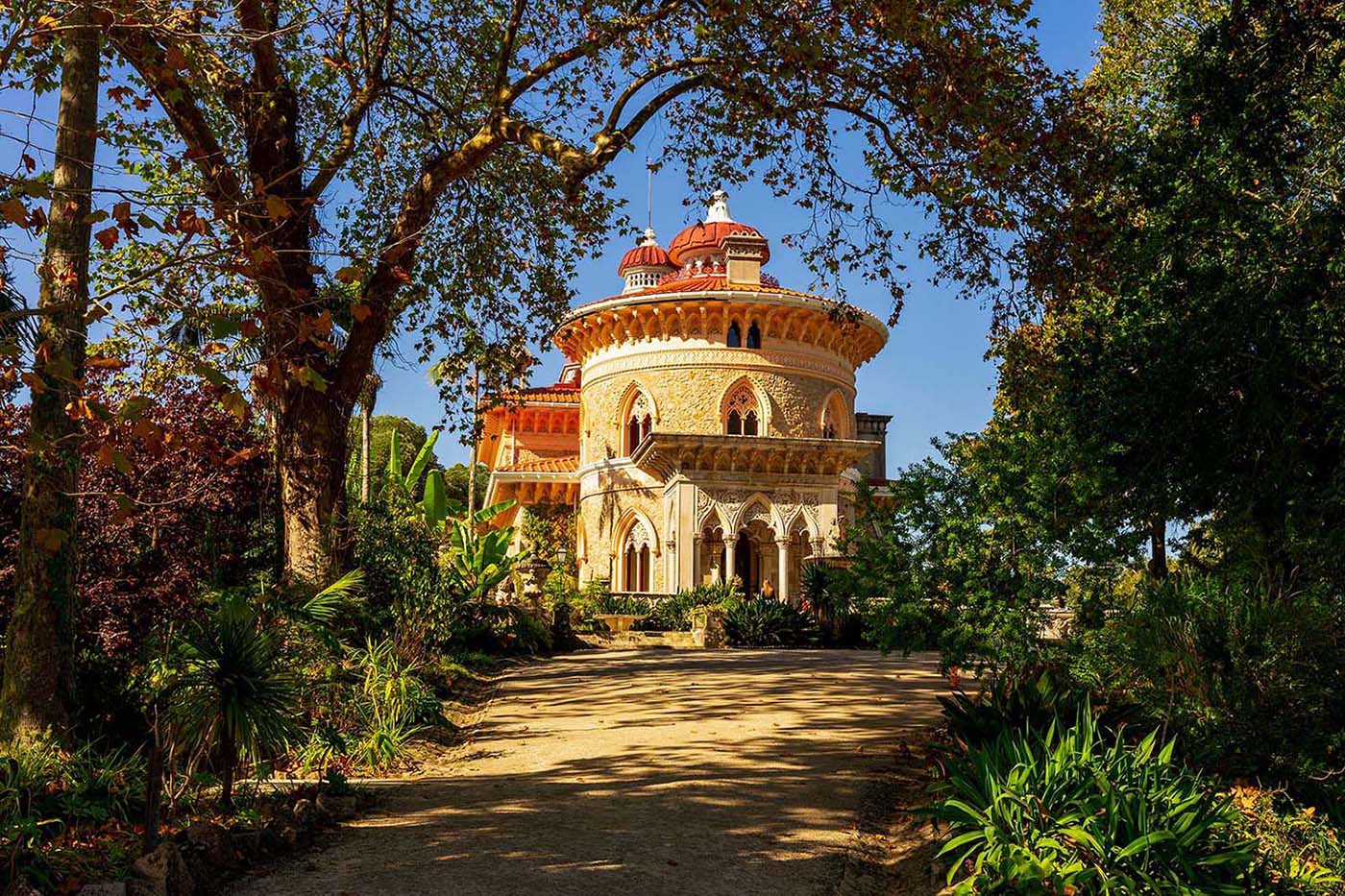
Monserrate Palace in Sintra © Shutterstock
Sintra has a mild Atlantic climate, with cooler temperatures and more humidity than Lisbon, thanks to its position in the Serra de Sintra hills. Mist and sudden shifts in weather are common; a sunny morning can turn foggy by afternoon, so layers are essential year-round. Average highs range from 57°F (14°C) in January to 77°F (25°C) in August. Many travelers consider late spring or early autumn the best time to visit Portugal, and Sintra is no exception; these months bring pleasant temperatures and manageable crowds. For current forecasts, check the IPMA (Portuguese Institute for Sea and Atmosphere).
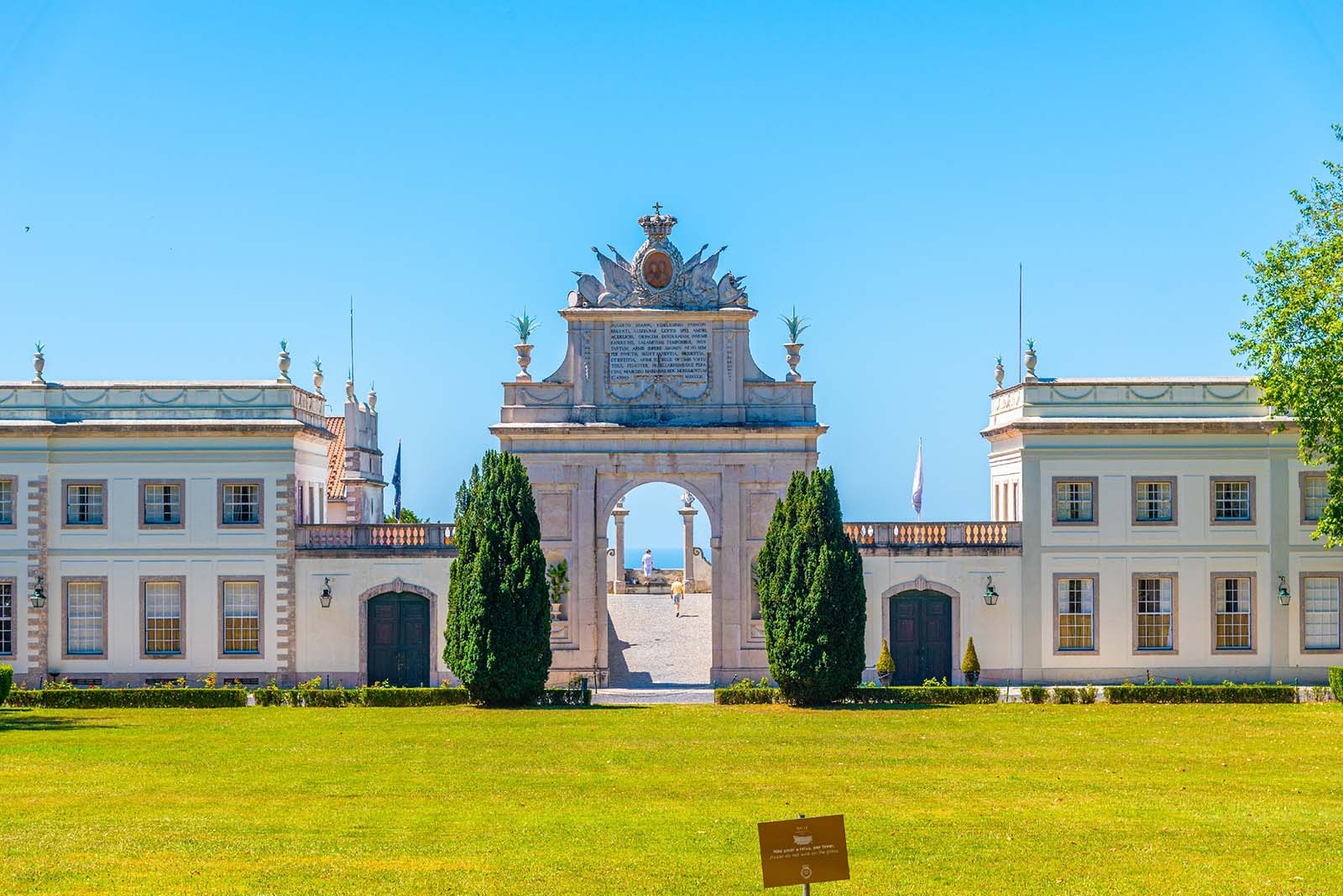
Palácio de Seteais at Sintra, Portugal © Shutterstock
Sintra’s food scene balances traditional Portuguese comfort dishes with cafés serving quick bites for day-trippers. You’ll also find a few elegant dining rooms tucked inside historic buildings, perfect for turning a palace-hopping day into a special evening.
Here are some unique experiences you can add to a tailor-made Sintra trip, all private, flexible, and designed by local travel experts.
Discover Portugal's most captivating stories
Use Rough Guides' trusted partners for great rates
written by
Olga Sitnitsa
Online editor at Rough Guides, specialising in travel content. Passionate about creating compelling stories and inspiring others to explore the world.